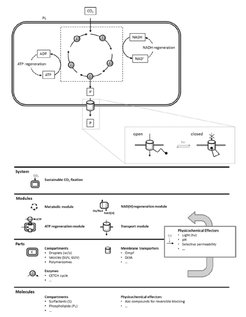Metabolism
Work Package L2
We also seek for the combination of modules and approaches from Work Package L1 with metabolic cascades, whereby the Landfester Group, Baret Group and Sundmacher Group are running enzymatic cascades in different types of microcompartments and coupling them with the respective regeneration modules.
The main goal of Work Package L2 is to establish cofactor- and energy-dependent enzymatic cascades in microcompartments. In the second funding phase we will focus on the CETCH cycle as a prime example of a synthetic pathway for the production of multi-carbon compounds (e.g. malate, glycerate, and pyruvate) from CO2 and will rely on closer integration of experimental and modeling work for understanding and optimization of this cascade. The CETCH cycle will be encapsulated in droplets and vesicles. Droplets will serve as an efficient tool for optimization of the cycle, based on the methodology developed by Universiy Bordeaux in the first period of MaxSynBio (2014-2017), while vesicles will be considered as the main system of interest for approximation of minimal metabolic cells. To achieve these goals, we will direct our efforts towards establishing and coupling transport and energy regeneration modules in vesicular systems.

After the realization of a functional carbon substrate uptake module, we will explore the dicarboxylic acid co-transporter DctA as a mean to release products from the CETCH cycle. With respect to the increasing attention of using light as an external trigger within MaxSynBio, the possibility of light-controlled transport will be investigated. Photoswitchable transporters could be potentially used to start reactions in vesicles and transport products, intermediates or signaling molecules out of the vesicles, once such a controllable module has been developed. To summarize, in the second funding phase functional modules will be upgraded, optimized and combined with each other.
